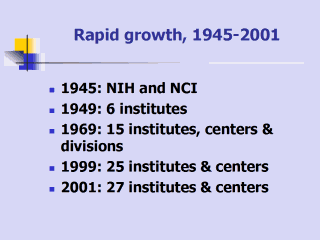 |
At the end of
World War II in 1945, there existed the National Institute [singular] of
Health and the National Cancer Institute. In 1946, Congress began creating
new institutes by authorizing a National Institute on Mental Health (which
was not given operating funds until 1949). In 1948, the Surgeon General
reorganized the existing NIH divisions into two institutes: the National
Microbiological Institute, comprising work on infectious diseases,
zoological diseases, and biologics; and the Experimental Biology and
Medicine Institute, which subsumed work in chemistry, pharmacology, and
nutrition. In 1948, Congress created a National Institute of Dental
Research, in part as a response to the impact bad teeth had made on the
fitness for military service of young men; and a National Heart Institute,
whose legislation included wording that made the umbrella organizationís
name plural: National Institutes of Health.
These six institutes had grown to 15 by 1969, to 25 by 1999, and to 27 by
2001.
|
